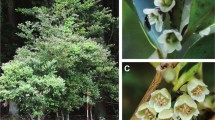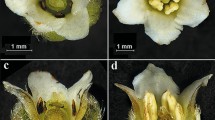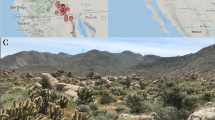Abstract
Unisexual flower development has long been used as a model system to understand the mechanism of plant sex determination. However, based on our investigation of the mechanisms regulating the development of unisexual cucumber flowers, we have realized that understanding how organ development is inhibited may not necessarily reveal how an organ is formed. We refer to this problem as a “bird–nest puzzle,” meaning one cannot understand how a bird lays and hatches its eggs by understanding how its nest is ruined. To understand the biological significance of unisexual flowers, we reexamine the original meaning of sex and its application in plants. Additionally, we propose that the fundamental biological advantage for the selection and maintenance of unisexual flowers during evolution is to promote cross pollination.
Similar content being viewed by others
References
Acosta IF, Laparra H, Romero SP, Schmelz E, Hamberg M, Mottinger JP, Moreno MA, Dellaporta SL (2009) tasselseed1 is a lipoxygenase affecting jasmonic acid signaling in sex determination of maize. Science 323(5911):262–265
Ainsworth CC (1999) Sex determination in plants, vol 1, Environmental stress and gene regulation. Sex determination in plants. BIOS Scientific Publishers, Oxford
Bai SN, Xu ZH (2010) From ethylene promotion of female flowers to ethylene inhibition of stamen development: a review on the study of developmental fate of inappropriate organs in suisexal cucumber flowers. Sci Sin Vitae 40(6):469–475
Bai SL, Peng YB, Cui JX, Gu HT, Xu LY, Li YQ, Xu ZH, Bai SN (2004) Developmental analyses reveal early arrests of the spore-bearing parts of reproductive organs in unisexual flowers of cucumber (Cucumis sativus L.). Planta 220(2):230–240
Boualem A, Fergany M, Fernandez R, Troadec C, Martin A, Morin H, Sari MA, Collin F, Flowers JM, Pitrat M, Purugganan MD, Dogimont C, Bendahmane A (2008) A conserved mutation in an ethylene biosynthesis enzyme leads to andromonoecy in melons. Science 321(5890):836–838
Boualem A, Troadec C, Kovalski I, Sari MA, Perl-Treves R, Bendahmane A (2009) A conserved ethylene biosynthesis enzyme leads to andromonoecy in two cucumis species. PLoS One 4(7):e6144
Bull JJ (1983) Evolution of sex determining mechanism, vol 1. Benjamin/Cummings Publishing, Berkeley. ISBN 0-8053-0400-2
Calderon-Urrea A, Dellaporta SL (1999) Cell death and cell protection genes determine the fate of pistils in maize. Development 126(3):435–441
Charlesworth D (2002) Plant sex determination and sex chromosomes. Heredity (Edinb) 88(2):94–101
Chuck G, Meeley R, Irish E, Sakai H, Hake S (2007) The maize tasselseed4 microRNA controls sex determination and meristem cell fate by targeting Tasselseed6/indeterminate spikelet1. Nat Genet 39(12):1517–1521
Coen ES, Meyerowitz EM (1991) The war of the whorls: genetic interactions controlling flower development. Nature 353(6339):31–37
Dellaporta SL, Calderon-Urrea A (1993) Sex determination in flowering plants. Plant Cell 5(10):1241–1251
DeLong A, Calderon-Urrea A, Dellaporta SL (1993) Sex determination gene TASSELSEED2 of maize encodes a short-chain alcohol dehydrogenase required for stage-specific floral organ abortion. Cell 74(4):757–768
Duan QH, Wang DH, Xu ZH, Bai SN (2008) Stamen development in Arabidopsis is arrested by organ-specific overexpression of a cucumber ethylene synthesis gene CsACO2. Planta 228(4):537–543
Efroni I, Blum E, Goldshmidt A, Eshed Y (2008) A protracted and dynamic maturation schedule underlies Arabidopsis leaf development. Plant Cell 20(9):2293–2306
Gilbert SF (2000) Developmental biology, 6th edn. Sinauer Associates, Sunderland
Gu HT, Wang DH, Li X, He CX, Xu ZH, Bai SN (2011) Characterization of an ethylene-inducible, calcium-dependent nuclease that is differentially expressed in cucumber flower development. New Phytol 192(3):590–600
Hao YJ, Wang DH, Peng YB, Bai SL, Xu LY, Li YQ, Xu ZH, Bai SN (2003) DNA damage in the early primordial anther is closely correlated with stamen arrest in the female flower of cucumber (Cucumis sativus L.). Planta 217(6):888–895
Huang S, Li R, Zhang Z, Li L, Gu X, Fan W, Lucas WJ, Wang X, Xie B, Ni P, Ren Y, Zhu H, Li J, Lin K, Jin W, Fei Z, Li G, Staub J, Kilian A, van der Vossen EA, Wu Y, Guo J, He J, Jia Z, Tian G, Lu Y, Ruan J, Qian W, Wang M, Huang Q, Li B, Xuan Z, Cao J, Asan WuZ, Zhang J, Cai Q, Bai Y, Zhao B, Han Y, Li Y, Li X, Wang S, Shi Q, Liu S, Cho WK, Kim JY, Xu Y, Heller-Uszynska K, Miao H, Cheng Z, Zhang S, Wu J, Yang Y, Kang H, Li M, Liang H, Ren X, Shi Z, Wen M, Jian M, Yang H, Zhang G, Yang Z, Chen R, Ma L, Liu H, Zhou Y, Zhao J, Fang X, Fang L, Liu D, Zheng H, Zhang Y, Qin N, Li Z, Yang G, Yang S, Bolund L, Kristiansen K, Li S, Zhang X, Wang J, Sun R, Zhang B, Jiang S, Du Y (2009) The genome of the cucumber, Cucumis sativus L. Nat Genet 41(12):1275–1281
Irish EE, Nelson T (1989) Sex determination in monoecious and dioecious plants. Plant Cell 1(8):737–744
Knopf RR, Trebitsh T (2006) The female-specific Cs-ACS1G gene of cucumber. A case of gene duplication and recombination between the non-sex-specific 1-aminocyclopropane-1-carboxylate synthase gene and a branched-chain amino acid transaminase gene. Plant Cell Physiol 47(9):1217–1228
Li Z, Liu S, Pan J, Zhang Z, Tao Q, Shi Q, Jia Z, Zhang W, Chen H, Si L, Zhu L, Huang S, Cai R (2009) Molecular isolation of the M gene suggests that a conserved-residue conversion induces the formation of bisexual flowers in cucumber plants. Genetics 182:1381–1385
Liu HH, Tian X, Li YJ, Wu CA, Zheng CC (2008) Microarray-based analysis of stress-regulated microRNAs in Arabidopsis thaliana. RNA 14(5):836–843
Martin A, Troadec C, Boualem A, Rajab M, Fernandez R, Morin H, Pitrat M, Dogimont C, Bendahmane A (2009) A transposon-induced epigenetic change leads to sex determination in melon. Nature 461(7267):1135–1138
Mibus H, Tatlioglu T (2004) Molecular characterization and isolation of the F/f gene for femaleness in cucumber (Cucumis sativus L.). Theor Appl Genet 109(8):1669–1676
Ming R, Wang J, Moore PH, Paterson AH (2007a) Sex chromosomes in flowering plants. Am J Bot 94(2):141–150
Ming R, Yu Q, Moore PH (2007b) Sex determination in papaya. Semin Cell Dev Biol 18(3):401–408
Nag A, King S, Jack T (2009) miR319a targeting of TCP4 is critical for petal growth and development in Arabidopsis. Proc Natl Acad Sci U S A 106(52):22534–22539
Palatnik JF, Allen E, Wu X, Schommer C, Schwab R, Carrington JC, Weigel D (2003) Control of leaf morphogenesis by microRNAs. Nature 425(6955):257–263
Rea AC, Nasrallah JB (2008) Self-incompatibility systems: barriers to self-fertilization in flowering plants. Int J Dev Biol 52(5–6):627–636
Robbins WW, Pearson HM (1933) Sex in plant world. D. Appleton-Century New York
Saito S, Fujii N, Miyazawa Y, Yamasaki S, Matsuura S, Mizusawa H, Fujita Y, Takahashi H (2007) Correlation between development of female flower buds and expression of the CS-ACS2 gene in cucumber plants. J Exp Bot 58(11):2897–2907
Stanley RG, Linskens HF (1974) Pollen: biology, biochemistry, management. Springer, Berlin
Sun JJ, Li F, Li X, Liu XC, Rao GY, Luo JC, Wang DH, Xu ZH, Bai SN (2010) Why is ethylene involved in selective promotion of female flower development in cucumber? Plant Signal Behav 5(8):1052–1056
Sunkar R, Zhu JK (2004) Novel and stress-regulated microRNAs and other small RNAs from Arabidopsis. Plant Cell 16(8):2001–2019
Tanurdzic M, Banks JA (2004) Sex-determining mechanisms in land plants. Plant Cell 16(Suppl):S61–71
Wang DH, Li F, Duan QH, Han T, Xu ZH, Bai SN (2010) Ethylene perception is involved in female cucumber flower development. Plant J 61(5):862–872
Yang LL, Chen M, Liu FQ, Geng Y, Chen C, Li YQ, Tsao TH, Xu ZH, Bai SN (2000) Carpel of cucumber (Cucumis sativus L.) male flowers maintains early primordia characteristics during organ development. Chin Sci Bull 45(8):729–733
Yu Q, Hou S, Feltus FA, Jones MR, Murray JE, Veatch O, Lemke C, Saw JH, Moore RC, Thimmapuram J, Liu L, Moore PH, Alam M, Jiang J, Paterson AH, Ming R (2008) Low X/Y divergence in four pairs of papaya sex-linked genes. Plant J 53(1):124–132
Acknowledgments
We thank Dr. Peter Nick of Universität Karlsruhe for his encouragement of writing down our opinion on unisexual flower development in an untraditional perspective. We also thank Ms. Na Liu for her assistance in formatting all citations using EndNote. The research on unisexual cucumber flowers was supported by grants from the Ministry of Science and Technology (J00-A-005, G19990116), the National Natural Science Foundation of China (30070361, 30470842), the Ministry of Education (211 project), and, especially, the International Center of Genetic Engineering and Biotechnology (CRP/CHN03-02).
Author information
Authors and Affiliations
Corresponding author
Additional information
Handling Editor: Peter Nick
Rights and permissions
About this article
Cite this article
Bai, SN., Xu, ZH. Bird–nest puzzle: can the study of unisexual flowers such as cucumber solve the problem of plant sex determination?. Protoplasma 249 (Suppl 2), 119–123 (2012). https://doi.org/10.1007/s00709-012-0396-4
Received:
Accepted:
Published:
Issue Date:
DOI: https://doi.org/10.1007/s00709-012-0396-4




